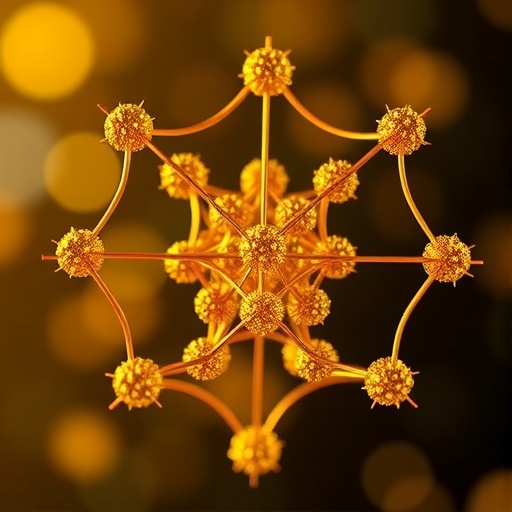In a groundbreaking study that promises to redefine our understanding of nanoparticle surface chemistry, researchers have uncovered the pivotal role of transient Au–Cl adlayers in modulating the surface properties of gold nanoparticles during redox reactions. Published recently in Nature Chemistry, this work reveals a dynamic chemical landscape on the surface of gold at the nanoscale, challenging long-standing assumptions and opening new doors for catalysis and materials science.
Gold nanoparticles have long been celebrated for their unique electronic and catalytic properties that diverge significantly from bulk gold. These properties depend sensitively on the surface chemistry, which in turn influences reactivity, stability, and selectivity in chemical processes. Despite intensive study, the transient nature of surface adsorbates—particularly the subtle and ephemeral interactions involving halide ions—has remained elusive due to limitations in characterization techniques and molecular-level control.
The research spearheaded by Sibug-Torres, Niihori, and Wyatt et al. employs state-of-the-art surface-sensitive techniques and theoretical modeling to expose how chloride ions interact with gold nanoparticle surfaces under redox conditions. Their meticulous observations reveal that these Au–Cl adlayers form and dissolve dynamically, profoundly affecting the nanoparticles’ surface chemistry in real time. This transient behavior contrasts sharply with the previously held view of static, well-defined surface adsorbates.
Beyond mere surface coverage, the presence of these chloride adlayers actively modulates electron transfer processes on the gold nanoparticles. During redox reactions, the Au–Cl layers alter the local electronic environment, facilitating or hindering reactivity by tuning the availability of active sites. This finding provides crucial insight into the factors that control catalytic efficiency and specificity—a long-standing challenge in nanocatalysis.
One of the most striking insights from the study is the mechanistic understanding of how these adlayers influence gold’s catalytic pathways. The researchers used a combination of electrochemical measurements, in situ spectroscopy, and atomistic simulations to demonstrate that the transient Au–Cl adlayers can reversibly delay or accelerate reaction steps, essentially working as an on-demand molecular switch. This mechanism suggests new strategies for dynamically controlling reaction kinetics at the nanoscale.
The significance of this discovery goes beyond gold nanoparticles alone. Chloride ions and related halides are ubiquitous in aqueous environments, and understanding their transient interactions with metal surfaces can inform broader fields such as corrosion science, environmental chemistry, and even the development of sensors. The ability to dynamically regulate surface chemistry through reversible adlayer formation heralds a paradigm shift in surface engineering.
Crucially, the study delineates how external conditions such as potential, pH, and ionic strength govern the stability and lifetime of these Au–Cl adlayers. By finely tuning experimental parameters, the team could modulate the adlayer dynamics, suggesting that such control can be harnessed in practical applications. This tunability opens new possibilities for designing responsive catalytic surfaces that adapt dynamically to changing reaction environments.
The ramifications extend to the design principles of nanomaterials, which often rely on fixed assumptions about surface states. The discovery of transient adlayer dynamics necessitates a revision of models used to predict nanoparticle behavior during catalysis, sensing, or electronic applications. As nanoparticles become central components in energy conversion and storage devices, this insight is particularly timely.
Interestingly, the transient adlayer phenomena also shed light on long-standing puzzles in electrocatalysis, such as unexpected variations in catalytic activity and selectivity under seemingly identical conditions. The presence or absence of these transient Au–Cl layers may account for discrepancies and confounding experimental observations reported in the literature.
The team’s approach combined sophisticated experimental probes, including in situ scanning tunneling microscopy and surface-enhanced Raman spectroscopy, allowing unprecedented real-time tracking of the surface adlayers under operational conditions. Complemented with density functional theory simulations, the holistic methodology set a new standard for probing nanoscale interfaces where chemical reactivity unfolds.
Future implications of this research are vast. By harnessing the dynamic nature of Au–Cl adlayers, it could become feasible to create “smart” catalysts that respond adaptively, enhancing reaction rates or selectively blocking undesired pathways. Such technological advancements could revolutionize fields from pharmaceuticals manufacturing to environmental remediation.
Moreover, the insight into halide-mediated modulation might inspire novel synthetic routes aimed at deliberately engineering transient surface coatings for a wide array of metal nanoparticles, expanding beyond gold to silver, copper, and beyond. Such generalizability would vastly broaden the impact of this fundamental discovery.
The narrative emerging from this research underscores an evolving appreciation for the complexity of nanoscale interfaces. Instead of static pictures, scientists must embrace dynamic molecular processes that fundamentally govern chemical transformations. This paradigm shift promises a richer, more nuanced understanding of catalytic mechanisms than ever before.
In sum, the revelation of transient Au–Cl adlayers transforming gold nanoparticle surface chemistry during redox reactions represents a milestone in nanoscale science. It highlights how subtle, fleeting interactions at surfaces wield outsized influence on material behavior and functionality. The study not only deepens fundamental chemical knowledge but also sets a course toward next-generation adaptive nanomaterials engineered for precision at the atomic scale.
As the scientific community digests these findings, the anticipation builds around the novel applications and innovations they will inspire. The dynamic control of surface chemistry, once a speculative possibility, now stands within reach—heralding a new era of chemically intelligent nanotechnology.
Subject of Research: Surface chemistry modulation of gold nanoparticles through transient Au–Cl adlayer formation during redox reactions.
Article Title: Transient Au–Cl adlayers modulate the surface chemistry of gold nanoparticles during redox reactions.
Article References:
Sibug-Torres, S.M., Niihori, M., Wyatt, E. et al. Transient Au–Cl adlayers modulate the surface chemistry of gold nanoparticles during redox reactions. Nat. Chem. (2025). https://doi.org/10.1038/s41557-025-01989-4
Image Credits: AI Generated
DOI: https://doi.org/10.1038/s41557-025-01989-4
Tags: catalytic properties of gold nanoparticlesdynamic chemical landscapeephemeral surface adsorbatesgold nanoparticle surface chemistryhalide ion interactionsmaterials science breakthroughsnanoparticle reactivity and stabilitynature chemistry research findingsredox reactions in nanoparticlesstate-of-the-art characterization techniquestheoretical modeling in nanotechnologytransient Au–Cl adlayers





